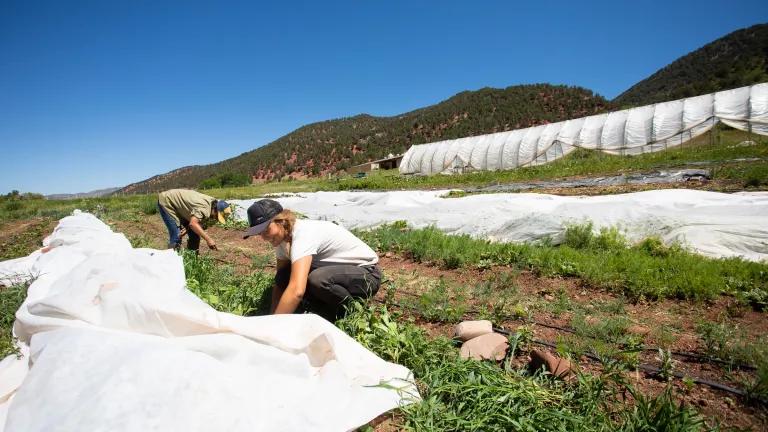Model Municipal Zoning Ordinance on Community Composting: With and Without Commentaries
Model policy language for adapting zoning codes to make community composting a permissible land use

Coauthored with Linda Breggin and Jessica Sugarman and Taalin RaoShah of the Environmental Law Institute
NRDC and the Environmental Law Institute (ELI) recently released a Model Municipal Zoning Ordinance on Community Composting, a template ordinance intended to advance community composting by establishing it as a permissible land use under a municipality’s zoning code—thus helping municipalities meet their climate and waste reduction goals while achieving various other co-benefits.
Downloads
The best way to address the problems associated with food waste—ecologically, socially, and economically—is not to waste the food in the first place. However, no matter how good we get at preventing food from going to waste and adopting the other strategies high up on the Wasted Food Scale, there will always be some scraps we will need to manage to avoid disposing of them in landfills or incinerators. Composting—the controlled, aerobic biological decomposition of organic material—is a critical strategy for recycling food waste to not only avoid disposal but to increase soil health.
Composting provides many environmental, economic, and social benefits. By diverting organic waste from landfills and incinerators, composting reduces emissions of GHGs—particularly methane, which has 80 times more planet-warming potential than carbon dioxide in the first 20 years after it is emitted. Composting can also decrease disposal costs associated with landfilling and incineration and can reduce the need for expansion or construction of new landfills and incinerators, which have harmful public health effects and are disproportionately sited in environmental justice communities. Additionally, the composting industry overall sustains more jobs than landfilling or incineration on a per-ton basis.
Applying compost to soil offers many benefits, too, including: sequestering carbon; preventing erosion; reducing stormwater runoff; and decreasing the need for chemical fertilizers, pesticides, and irrigation.
Composting can take place across a spectrum of sites and operational scales, from backyard composting to community composting to large-scale industrial facilities. This model focuses on community composting, defined primarily by its community scale and local character—i.e., composting at a smaller scale than industrial level, sourcing organic material locally, using the finished compost on local soil, and generally engaging the community in the composting process.
Community composting is designed to meet local needs, serve local interests, and engage the community in a variety of ways; for example, community composting facilities may provide education on food systems and sustainability, local green space for community members to enjoy, and local jobs and job training. Community composting’s small size and local focus can also simplify quality control and reduce costs and emissions related to hauling and distribution.
Community composting can also be a powerful tool to promote equity, including by empowering environmental justice community members—especially youth—through jobs and job training and by filling service access gaps in communities where there are no municipally provided organics recycling opportunities. Finished compost can also support bioremediation and food sovereignty in environmental justice communities.
Unfortunately, zoning can be an unintended barrier for community composters. Under Euclidean zoning—the most popular approach to municipal zoning in the United States—municipalities typically establish zoning district categories (e.g., residential, commercial, and industrial) and regulate the land uses that are allowed in each. If a zoning code treats composting facilities the same way that it treats large waste facilities such as landfills and incinerators—or if the zoning code doesn’t explicitly cover composting at all—then local zoning laws may unnecessarily prevent or restrict the siting of community composting facilities.
The model is intended to help municipalities remove this potential barrier by providing clean, “off-the-shelf” legal language to establish and govern community composting as a permissible land use across five basic zoning district categories: commercial and industrial (in which community composting is zoned by right as a primary use); agricultural (by right as an accessory use); and residential and mixed use (conditional use). The model also sets specific standards that are necessary to obtain the conditional use permit (which is required in residential and mixed-use zones) and lays out other relevant provisions to regulate community composting as a land use, such as prohibited feedstocks. Where applicable, the model also requires that community composting be included in a municipality’s comprehensive or master plan in order to help secure its place in official visions for the municipality’s future.
The off-the-shelf version of the model is accompanied by a version with commentaries and a background memorandum, which offer alternative approaches and additional information to help municipalities tailor the model to their local circumstances. For example, because community composting can take many different forms and operate at varying sizes, its definition in the model is intentionally flexible; a municipality could choose to include a quantitative threshold, such as throughput volume or facility area, to determine what qualifies as a community composting facility.
A slide deck is also provided to help municipal staff or community members share the model with decision-makers and other stakeholders.
The Model Municipal Zoning Ordinance on Community Composting takes as its starting point the model zoning template and guidelines published by the U.S. Composting Council, building on this work in part by focusing specifically on community composting. The model also relies on the extensive resources and experience of the Institute for Local Self-Reliance. According to Brenda Platt, Director of ILSR's Composting for Community Initiative, "Zoning rules and lack of access to land are top barriers to hyperlocal composting. This model ordinance addresses both and we encourage cities to take a serious look at how they could adopt it."
The model is part of an ongoing effort to provide municipalities and advocates with tools to reduce the time and resources associated with taking food waste reduction actions. Other model municipal policy tools published by NRDC and ELI include:
- Model Ordinance Establishing a Pay-As-You-Throw Program for Residential Municipal Solid Waste;
- Model Executive Order on Municipal Leadership on Food Waste Reduction;
- Model Ordinance on Mandatory Reporting for Large Food Waste Generators; and
- Model Compost Procurement Policy.
Additional policy resources and information can be found at the sites for ELI’s Center for State and Local Governance, the ELI Food Waste Initiative, and NRDC's Food Matters program.


